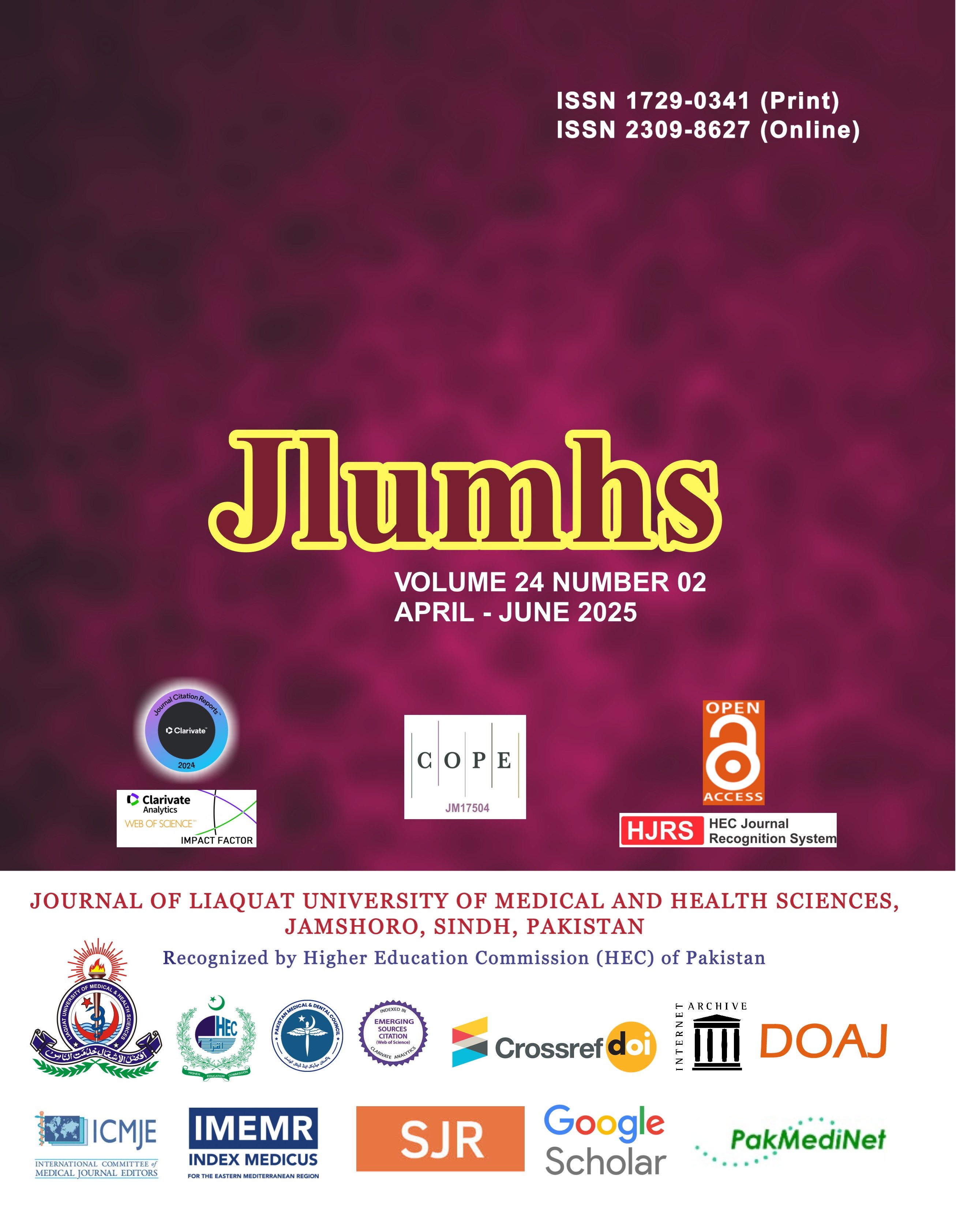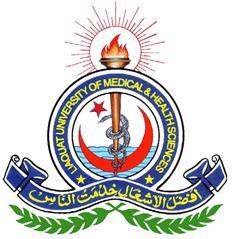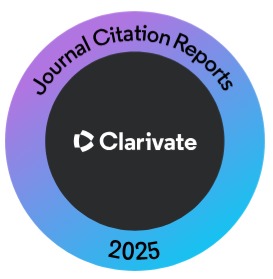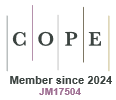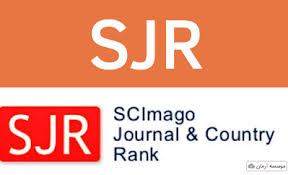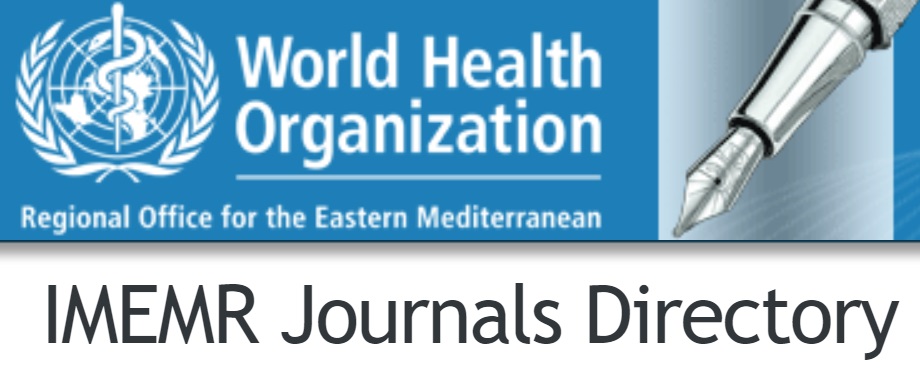Prenatal Visits as Determinants of Maternal Hemoglobin Level and Neonatal Birth Weight in Tertiary Care Hospital
Keywords:
Antenatal care, prenatal care, Low birth weight, Anemia, antenatal attendance, adverse pregnancy outcome, neonatal birth weightAbstract
OBJECTIVE: To determine the association between the number of prenatal visits, maternal hemoglobin level, and birth weight of newborns.
METHODOLOGY: This cross-sectional study was conducted in the Department of Obstetrics & Gyneacology, Darul Sehat Hospital, Karachi, from July 2022 to January 2023. Females with any parity and full-term gestational age, regardless of mode of delivery, were included, while patients with preterm deliveries, miscarriages, and referred cases were excluded. The convenience non-probability technique is a method of sampling. A questionnaire containing demographic information, the number of antenatal visits, and the timing of the first visit to the hospital, as well as Hb level at the time of birth and fetal outcome, was introduced. The Chi-square test was used to assess the association between variables. SPSS 21 was used for data calculation.
RESULTS: 155 women were interviewed. The mean age of the respondents was 29±6.2 years, the mean parity was 2.2±1.07, and the mean number of visits was 6.3±3.2. 34% had eight or more visits. The mean gestational age at booking is 16.7±9.4 weeks, and the mean Hb level of the population is 10.1g/dl±1.2. 67% of the population is found to be anemic. A p-value of (0.04) indicates a relationship between the mother's hemoglobin level and prenatal visits. 52.3% of newborns were born with low birth weights.
CONCLUSION: Prenatal attendance is significantly associated with maternal hemoglobin level and neonatal birth weight. The number and quality of prenatal visits must be ensured at the national level to improve maternal and neonatal health.
References
Balk EM, Konnyu K, Cao W, Bhuma MR, Danilack VA, Adam GP et al. Schedule of visits and televisits for routine antenatal care: a systematic review. [Internet]. doi: 10.23970/AHRQEPCCER257.
Tuncalp O, Were WM, MacLennon C, Oladapo OT, Gulmezoglu AM, Daelmans B et al. Quality of care for pregnant women and newborns—the WHO vision. BJOG. 2015; 122(8); 1045-1049. doi: 10.1111/1471-0528.13451.
Organization WH. Trends in maternal mortality 2000 to 2017: estimates by WHO, UNICEF, UNFPA, World Bank Group and the United Nations Population Division: executive summary. World Health Organization; 2019. Available from: https://iris.who.int/handle/10665/327596.
Organization WH. WHO recommendations on antenatal care for a positive pregnancy experience. World Health Organization. 2016. Available from: https://www.who.int/publications/i/item/9789241549912
Benova L, Tunçalp Ö, Moran AC, Campbell OM. Not just a number: examining coverage and content of antenatal care in low-income and middle-income countries. BMJ Glob Health. 2018 Apr 1; 3(2): e000779.
Knoema. Pakistan Maternal mortality ratio, 1960-2021. Available from: https://knoema. com/atlas/Pakistan/topics/Health/Health-Status/Maternal-mortality-ratio.
NIPS I. Pakistan demographic and health survey 2017-18. Islamabad, Pakistan, and Rockville, Maryland, USA: NIPS, ICF. 2019; 2.
Bucher S, Marete I, Tenge C, Liechty EA, Esamai F, Patel A et al. A prospective observational description of frequency and timing of antenatal care attendance and coverage of selected interventions from sites in Argentina, Guatemala, India, Kenya, Pakistan and Zambia. Reprod Health. 2015; 12: 1.
Arif A, Sherani A, Uzma Q, Alam B, Thom E, Abro A et al. Maternal and Perinatal Death Surveillance and Response in Balochistan, Pakistan-Causes & Contributory Factors of Maternal Deaths. J Gynecol Obsts. 2022; 10(1): 1-5.
Vale CC, Almeida NK, Almeida RM. Association between prenatal care adequacy indexes and low birth weight outcome. Revista Brasileira de Ginecologia e Obstetrícia. 2021 Apr; 43(04): 256-63.
Ahmed S. Impact of antenatal care on Birth weight in Pakistan. J Pak Med Assoc. 2022; 72(3): 537-542.
Khan MA. Antenatal care utilization in Pakistan. J Health Sci. 2020; 10(2): 123-132.
Midhet F, Hanif M, Khalid SN, Khan RS, Ahmad I, Khan SA. Factors associated with maternal health services utilization in Pakistan: Evidence from Pakistan maternal mortality survey, 2019. PloS One. 2023; 18(11): e0294225.
Pervin J, Venkateswaran M, Nu UT, Rahman M, O'Donnell BF, Friberg IK et al. Determinants of utilization of antenatal and delivery care at the community level in rural Bangladesh. PloS One. 2021; 16(9): e0257782.
Gillani S, Ahmad TI, Wang F, Shafiq MN. Antenatal Care (ANC) Coverage, Health Infrastructure, and Postnatal Care (PNC) Services Utilization: A District Level Analysis of Punjab-Pakistan. iRASD J Econ. 2021; 3(3): 318-31.
Agha S, Tappis H. The timing of antenatal care initiation and the content of care in Sindh, Pakistan. BMC Pragn Childbirth. 2016; 16: 1-9.
Martin JA, Osterman MJ. Changes in Prenatal Care Utilization: United States, 2019-2021. National Vital Statistics Reports: From the Centers for Disease Control and Prevention, National Center for Health Statistics, National Vital Statistics System. 2023; 72(4): 1-4.
Fetene W, Mekonnen A, Shiferaw Z, Genet A, Haile S. Timely initiation of first antenatal care visit and associated factors among pregnant women in the Amhara Region, North-west Ethiopia: a comparative cross-sectional study. Pan Afr Med J. 2023; 44: 51. doi: 10.11604/pamj.2023.44.51.33997.
Abaane DN, Adokiya MN, Abiiro GA. Factors associated with anaemia in pregnancy: A retrospective cross-sectional study in the Bolgatanga Municipality, Northern Ghana. PloS One. 2023; 18(5): e0286186.
Fan X, Zhou Z, Dang S, Xu Y, Gao J, Zhou Z et al. Exploring status and determinants of prenatal and postnatal visits in western China: in the background of the new health system reform. BMC Public Health. 2018; 18: 39.
Thakkar N, Alam P, Saxena D. Factors associated with underutilization of antenatal care in India: Results from 2019–2021 National Family Health Survey. PloS One. 2023; 18(5): e0285454.20.
Okedo-Alex IN, Akamike IC, Ezeanosike OB, Uneke CJ. Determinants of antenatal care utilization in sub-Saharan Africa: A systematic review. BMJ Open. 2019; 9(10): e031890.
Azhar BS, Islam MS, Karim MR. Prevalence of Anemia and associated risk factors among pregnant women attending antenatal care in Bangladesh: a cross-sectional study. Prim Healthcare Res Develop. 2021; 22: e61.
Noh JW, Kim YM, Lee LJ, Akram N, Shahid F, Kwon YD et al. Factors associated with the use of antenatal care in Sindh province, Pakistan: A population-based study. PloS One. 2019; 14(4): e0213987.
Gardner ME, Umer A, Rudisill T, Hendricks B, Lefeber C, John C et al. Prenatal care and infant outcomes of teenage births: a Project WATCH study. BMC Pregn Childbirth. 2023; 23(1): 379.
Ngo N, Bhowmik J, Biswas RK. Factors Associated with Low Birthweight in Low-and-Middle Income Countries in South Asia. Int J Environ Res Public Health. 2022; 19(21): 14139.
Shahani Z, Shaikh AR, Gemnani VK, Abro K, Aizuddin AN, Manaf MR et al. Neonatal Morbidity Patterns and Admission Outcomes: A Cross-Sectional Study at a Tertiary Care Hospital in Pakistan. J Pharmaceut Res Int. 2022: 72-6.
Shah T, Khaskheli MS, Ansari S, Lakhan H, Shaikh F, Zardari AA, Warsi J, Rind NA, Rind KH, Shar AH. Gestational Anemia and its effects on neonatal outcome in the population of Hyderabad, Sindh, Pakistan. Saudi J Biol Sci. 2022; 29(1): 83-7.
Shaeen SK, Tharwani ZH, Bilal W, Islam Z, Essar MY. Maternal mortality in Pakistan: challenges, efforts, and recommendations. Ann Med Surg. 2022; 81.
Downloads
Published
How to Cite
Issue
Section
License
Copyright (c) 2025 Journal of Liaquat University of Medical & Health Sciences

This work is licensed under a Creative Commons Attribution-NonCommercial-ShareAlike 4.0 International License.
Submission of a manuscript to the journal implies that all authors have read and agreed to the content of the undertaking form or the Terms and Conditions.
When an article is accepted for publication, the author(s) retain the copyright and are required to grant the publisher the right of first publication and other non-exclusive publishing rights to JLUMHS.
Articles published in the Journal of Liaquat University of Medical & health sciences are open access articles under a Creative Commons Attribution-Noncommercial - Share Alike 4.0 License. This license permits use, distribution and reproduction in any medium; provided the original work is properly cited and initial publication in this journal. This is in accordance with the BOAI definition of open access. In addition to that users are allowed to remix, tweak and build upon the work non-commercially as long as appropriate credit is given and the new creations are licensed under the identical terms. Or, in certain cases it can be stated that all articles and content there in are published under creative commons license unless stated otherwise.

